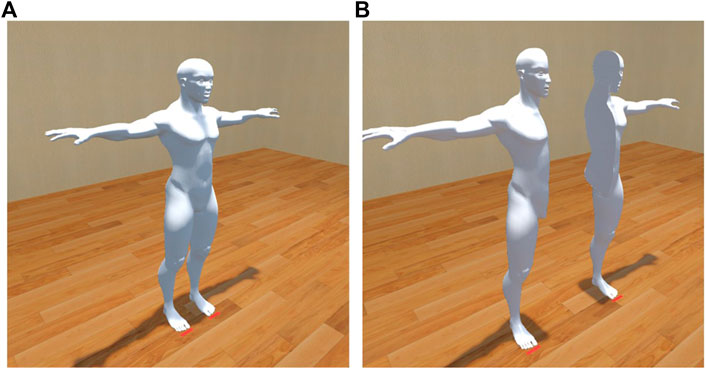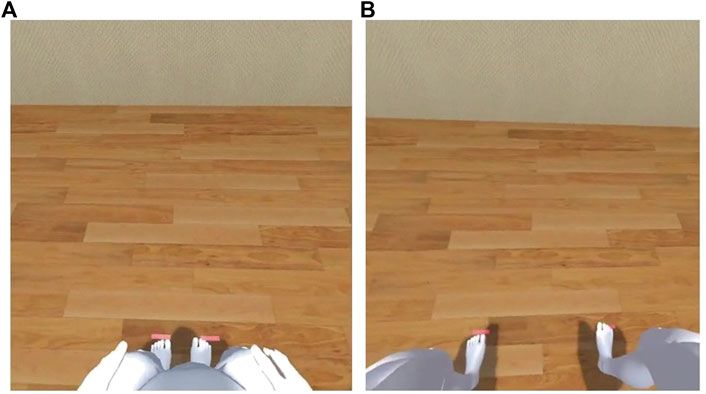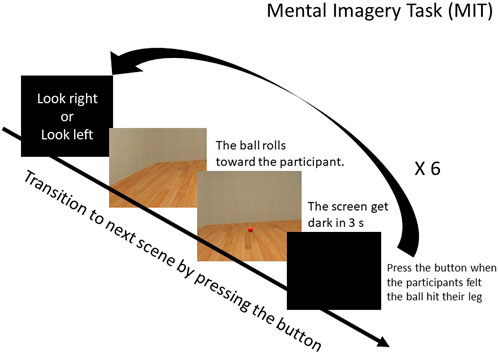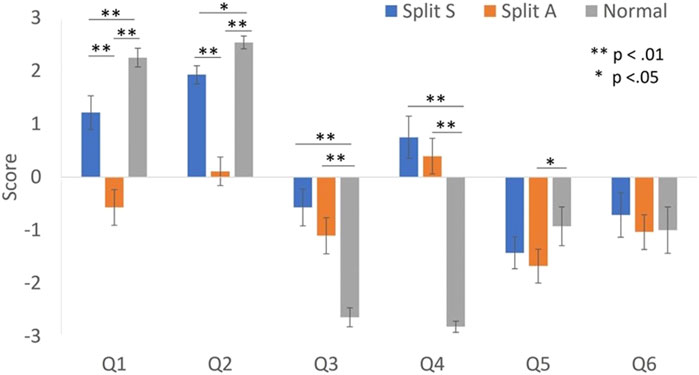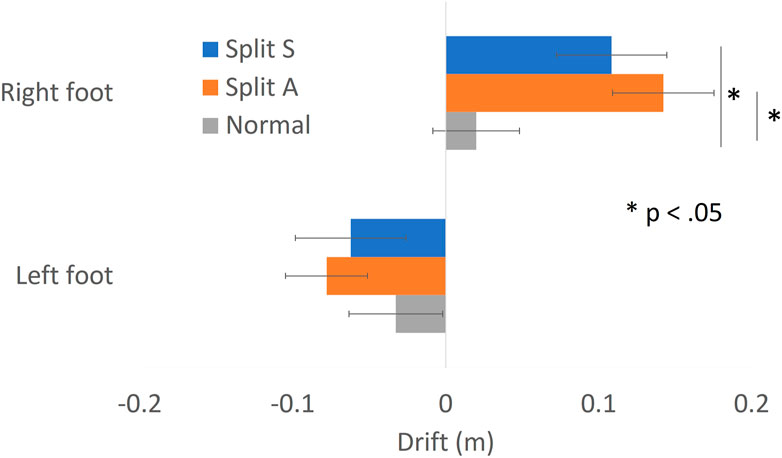- Department of Information and Computer Science, Keio University, Yokohama, Kanagawa, Japan
Is it possible to feel part of one’s own body even when the body part is separated from the body? If so, we could exist in different locations by splitting the self-body and using our body in each location. In a study in which the illusion that two bodies are one’s own body was induced using virtual reality (VR), the participants felt as if they were at two locations through the two bodies. However, this illusion was weak and reported only subjectively. We hypothesized that this was because two presented bodies moved synchronously with one participant’s movement or the simultaneous stroking of one participant’s body and two presented bodies switched their attention and weakened body ownership. In this study, we investigated whether splitting one body into left and right in VR could induce body ownership and extend the self-location while maintaining a one-to-one correspondence between the participant’s body and the presented body. The results showed that weaker body ownership was induced in the split body than in the normal body and self-location was extended to the right side of the body. The participants did not report a sense of having more than one body but reported a sense of body spreading, suggesting that the split bodies were perceived as a single body extending to the right side.
Introduction
Humans have a body with four connected limbs. When a body part is separated from the body, it becomes uncontrollable and is no longer part of the body. If one’s body part is separated from oneself and can still be moved, is it possible to feel that it is one’s body part? If so, we could exist in different locations by splitting our body and using them in each location.
Illusory body ownership
The sense that a body is one’s own body is called body ownership (BO) (Gallagher, 2000) and it can be induced in a not-innate body. In the rubber hand illusion (Botvinick and Cohen, 1998; Tsakiris and Haggard, 2005), an experimenter simultaneously strokes a participant’s hand and a rubber hand with a brush, and the participant observes only the rubber hand, making the rubber hand feel as if it was his/her own body. When the position of the hand that the participant feels is measured, the position of the hand drifts toward the rubber hand. Thus, we can feel as if the non-innate body was our own body by presenting tactile stimuli synchronized with visual stimuli (visual–tactile synchronization). Visual stimuli synchronized with the participant’s movements (visual–motor synchronization) also produce IBO. In the virtual hand illusion (Sanchez-Vives et al., 2010), the motion of the virtual hand is synchronized with the motion of a participant’s hand, so that the virtual hand feels as if it was one’s hand. Moreover, the movement of the virtual hand feels as if it was one’s own movement (sense of agency: SoA; Gallagher, 2000).
Full-body illusion
The aforementioned illusions occur not only for the hand but also for the full body. In a study using visual–tactile synchronization, IBO is generated by simultaneously stroking a mannequin and a participant’s body and observing the mannequin from its head using a head-mounted display (HMD) (Petkova and Ehrsson, 2008). The illusion is also produced when a full-body avatar moves synchronously with a participant’s motion (Gonzalez-Franco et al., 2010). When the self-body or virtual body is observed from a third-person perspective and IBO is generated for the body, the self-location drifts toward the observed body (Lenggenhager et al., 2007, 2009; Maselli and Slsater, 2014; Nakul et al., 2020).
Extending self-location by multiple bodies
It has been reported that the sense of being in two locations can be generated through two bodies (Aymerich-Franch et al., 2016; Guterstam et al., 2020). In a study conducted by Aymerich-Franch et al. (2016), participants controlled a robot and observed themselves controlling the robot from the robot’s viewpoint. After that, the participants answered a self-location questionnaire, “How strongly did you feel in both bodies at the same time” on a seven-level Likert scale. As a result, they felt as if they were in both their own body and the robot’s position. Guterstam et al. (2020)placed two mannequins, A and B, in a room so that mannequin A could see mannequin B from mannequin A’s viewpoint and vice versa, and the viewpoints of mannequin A and B were switched at regular intervals. Then, participants were given a map of the experimental room showing the mannequin positions and were asked to rate how strongly they felt as if they were there for each mannequin position on a visual analog scale from 0–10. As a result, the participants felt as if they were in both mannequins’ positions. However, the sensation of being at the two locations in the aforementioned studies is very weak and is only reported subjectively. The reason for this may be that the two bodies moved in response to one participant’s movement or that stroking one participant’s body and two bodies simultaneously resulted in a one-to-two correspondence, which switched attention and weakened the BO for each body. Furthermore, in a study in which multiple avatars were manipulated simultaneously, attention switched between avatars when manipulating them, and the ownership of two avatars was weaker than that of one avatar (Miura et al., 2022). Based on the aforementioned studies, we considered that extending self-location using multiple bodies is currently difficult and that the method of transforming a single body with established behavioral measurements would be easy to extend self-position.
Body continuity
BO is also generated when body continuity is lost due to the disappearance of all except hands and feet (Kondo and Sugimoto, 2018; Kondo and Ueda., 2018; Kondo et al., 2020) or the disappearance of the tip of a virtual arm (Kilteni et al., 2016). In our previous studies (Kondo and Sugimoto, 2018; Kondo and Ueda, 2018; Kondo et al., 2020), when only hands and feet were synchronized with a participant’s movement, an invisible body was perceived between the hands and feet and BO was generated in that space. When the position of the hands and feet was randomized, the ownership of the invisible body was lost, but the ownership of the hands and feet remained (Kondo et al., 2020). The results suggest that a spatial relationship is crucial for full-body illusion, but not for ownership of body parts. Kilteni et al. (2016)generated IBO even when the tip of a virtual arm disappeared. Thus, IBO is induced even when a body part disappears and body continuity is lost.
Aim
Because BO is generated even when body continuity is lost, we considered that extending the self-location might be possible by splitting the body while maintaining a one-to-one correspondence between a participant’s body and the presented bodies. In this study, we investigated whether BO is induced in a body split from the center to the left or right by moving in synchronization with the participant’s movement and whether self-location is extended to the left or right by body splitting.
Methods
Participants
A total of 28 volunteers (mean of 24.96 years old ±6.93 standard deviation; 24 males and 4 females; 22 right-handed, 5 left-handed, and one ambidextrous) gave written informed consent and participated in our experiment. The sample size was determined using G*Power 3.1 (Faul et al., 2007; Erdfelder et al., 2009) (repeated measures ANOVA, three avatar conditions, medium effect size f = 0.25, α = 0.05, power (1 − β) = 0.8). The participants had normal vision and physical abilities. This study was approved by the research ethics committee at the Faculty of Science and Technology, Keio University.
Apparatus and stimuli
The participants observed a full-body avatar (Figure 1) in a virtual environment from a first-person perspective (Figure 2) through an HMD (HTC Vive Pro Eye, 2,880 × 1,600 pixels, 90 Hz, 110°). The virtual environment was created by Unity 2017.4.5f11. There were three avatar conditions in the experiment: a full-body avatar split to the left and right moved synchronously (split S), the split avatar moved asynchronously (split A: 1-s delay on both sides), and the full-body avatar moved synchronously with a participant’s movement (normal). In the split conditions, splits S and A, the viewpoint was located between the split heads. The participants wore a motion capture suit and their movements were tracked by using 24 OptiTrack cameras (14 PrimeX 22 cameras: 2,048 × 1,088 pixels, 120 Hz; six Prime 17 W cameras: 1,664 × 1,088 pixels, 120 Hz; four Prime 13 cameras: 1,280 × 1,024 pixels, 120 Hz). In the experiment, the participants held two Vive controllers for a questionnaire and a behavioral task.
Procedures
The experiment began with the practice of a mental imagery task (MIT). We developed the MIT as a measurement of self-location based on the one proposed by Nakul et al. (2020). In the MIT, a ball’s direction was indicated by letters on a darkened screen, and the participants were instructed to turn only their heads in the indicated direction (Figure 3). Then, when a participant pressed a button, an image of the room was shown; when the button was pressed again, a virtual ball rolled toward the participant. After the ball started to move for 3 s, the screen turned dark. The participants were instructed to imagine the ball’s movement even after the darkening and to press the button on the controller when they felt that the ball hit their right or left foot if it rolled from the right or left, respectively. The position was recorded as the estimated self-location of the foot. The MIT was performed three times on each side randomly. The participants performed the MIT again for six trials as a baseline.
Next, the avatar was presented, and the participants were asked to move their limbs in the following order—right hand, left hand, right foot, and left foot—to the presented sounds through headphones every 2 s for 120 s (learning session). The participants performed the MIT and answered a questionnaire (Table 1) on a seven-level Likert scale (−3: did not feel at all, 0: uncertain, and +3: felt very strongly). From the learning session to the questionnaire, three trials were performed randomly, one for each avatar condition.
Results
The Shapiro–Wilk test was performed on the questionnaire and MIT results. We observed that the questionnaire results did not follow a normal distribution. Therefore, the Wilcoxon signed-rank test was performed, and the p-value was corrected using the Bonferroni method. The MIT results were divided into right and left feet, and a repeated measures ANOVA was employed. Shaffer’s method was used for multiple comparisons.
Questionnaire
Participants felt that the avatar’s body was more like their own body under split S than under split A (Figure 4: Q1 split S vs. split A: z = 3.89, p ≤ 0.001, r = 0.74). However, BO was stronger under normal than under split S or A (Q1 normal vs. split S: z = −3.10, p = 0.0034, r = 0.59; normal vs. split A: z = −4.56, p < 0.001, r = 0.86). The participants felt that the movement of the avatar’s body was more like their own movement under normal or split S than under split A (Q2 split S vs. split A: z = 4.23, p < 0.001, r = 0.80; normal vs. split A: z = −4.49, p < 0.001, r = 0.85). The sense was higher for normal than split S (Q2 split S vs. normal: z = −2.80, p = 0.011, r = 0.53).
On a question about multiple bodies, the score was higher when the split avatar was presented regardless of synchronization (Q3 split S vs. normal: z = 3.68, p < 0.001, r = 0.70; split A vs. normal: z = 2.85, p = 0.0082, r = 0.54). On a question about the feeling of splitting, the participants said they felt more like their bodies were split for the split avatars than for the normal avatar, regardless of synchronization (Q4 split S vs. normal: z = 4.28, p < 0.001, r = 0.81; split A vs. normal: z = 4.59, p < 0.001, r = 0.87).
In control questions (Q5 and Q6), the score was higher under normal than split A (Q5 normal vs. split A: z = -2.49, p = 0.044, r = 0.47).
MIT
Only the right foot showed the main effect of the avatar condition (F (2, 54) = 6.75, p = 0.0024,
Discussion
Summary of results
In this study, we investigated whether BO is generated for the body split into left and right and whether self-location extends to the left and right. The results showed that when the split body moved in synchronization with a participant’s movement, BO and a SoA were generated. However, the BO and SoA were weaker than those of the normal body. In the self-location, the perceived position of the right foot drifted to the right when the body was split, regardless of body synchronization.
Effects of body splitting on BO and SoA
In this study, BO and SoA were weaker when the body was split than in the normal body. This result is similar to that of a study in which the senses of ownership and agency were no longer generated when a part of the arm was removed (Tieri et al., 2015). However, a weak BO (mean: 1.2) and strong SoA (mean: 1.9) were still generated, suggesting that this phenomenon may be different from the study in which they were not generated at all (Tieri et al., 2015). Because the split body in this study was split from the center, the continuity of the limbs being moved was maintained. Therefore, if the continuity of moving body parts is maintained, the BO and SoA may be maintained.
Moreover, BO may have decreased due to the body being too far from the left and right, which did not complement body continuity. The invisible body studies in which an invisible body between hands and feet was complemented and perceived from the synchronous movements of only hands and feet (Kondo and Sugimoto, 2018; Kondo and Ueda, 2018; Kondo et al., 2020) and the study in which BO equivalent to that of connected body parts was induced by hiding disconnected body parts with objects (Tieri et al., 2015) suggest the relevance of the complementation of body continuity.
Another possible reason for the decrease in BO could be the effect of the body’s appearance. As it has been reported that BO does not occur for wooden sticks, which are far from the human body in appearance (Tsakiris and Haggard, 2005), BO could have decreased because the split body’s appearance was far from that of a human body. In addition, there is a study in which a strong BO was generated only by the congruence of visual stimuli and proprioception (Carey et al., 2019; Keenaghan et al., 2020), and the body presented in a position that was shifted to the left or right may have weakened the BO. However, another study showed that BO did not decrease when a body was shifted to a closer position (Maselli and Slater, 2014), as in this study, and further study is needed in the future.
Multiple bodies or one split body?
In the questionnaire, the mean value of Q3 “I felt as if I had two bodies” was lower than 0 under all conditions, and in Q4 “I felt as if my body had split and spread to the left and right,” the split bodies had a higher score than the normal body. Therefore, it seems that the split bodies were perceived as a single body spread to the left and right, rather than multiple bodies. In addition, the self-location drifted only on the right side, suggesting that the body was perceived as extended to the right side. Possible reasons the self-location drifted only on the right side include the fact that most participants were right-handed and they were asked to move from their right hand during the learning session.
In this study, the sense of one’s body splitting and spreading to the left and right (Q4), and the drift of self-location, occurred even under split A, suggesting that even in the absence of BO, the self-location can be extended by the presentation of a split body. Some studies support this result, reporting that BO and self-location drift are independent phenomena (Abdulkarim and Ehrsson, 2016; Matsumiya, 2019).
Control question
The score for control question Q5 “I felt naked” was higher under normal than under split A. The avatars used in the experiment were likely naked, which increased ratings under normal, where the BO was strongest. However, the mean value was less than 0, suggesting that the participants did not feel as if they were naked.
Limitation
In this study, we investigated whether BO is induced in a split body, but we could not measure BO on the right and left sides of the split body. BO may be induced only on the right half of the body because the self-location drifted only on the right side. However, because some scholars have reported that BO and self-location drift are independent phenomena (Abdulkarim and Ehrsson, 2016; Matsumiya, 2019), it is necessary to measure them using questionnaires for each of the left and right halves or with other measurements, such as the skin conductance response. In addition, although BO was generated in the split body, it is unclear whether the empty space between the left and right split bodies was perceived as one’s own body, as in our previous studies (Kondo and Sugimoto, 2018; Kondo and Ueda, 2018; Kondo et al., 2020). Thus, it is still unclear whether the split body was perceived as one body, including the empty space, or whether only the split body was perceived as one’s own body.
In this study, the split body was presented at a position shifted 30 cm from the body center. The reason is that some studies indicate that when the distance between the innate and non-innate bodies is far, BO is weak (Lloyd, 2007; Kalckert and Ehrsson, 2014; Maselli and Slater, 2014). However, when the task is performed with splitting, it is necessary to split farther or dynamically adjust the splitting distance. In future studies, we will examine BO, SoA, and controllability when participants split a virtual body far or when the distance of the split body can be dynamically controlled.
In the results of the MIT, left-handed participants tended to drift more strongly to the left than right-handed participants regardless of the condition, but there was no significant difference between the right-handed and left-handed (F (1, 25) = 3.43, p = 0.076,
Data availability statement
The raw data supporting the conclusion of this article will be made available by the authors, without undue reservation.
Ethics statement
The studies involving human participants were reviewed and approved by the Research Ethics Committee at the Faculty of Science and Technology, Keio University. The patients/participants provided their written informed consent to participate in this study.
Author contributions
RK and MS conceived and designed the experiments. RK collected and analyzed the data. RK and MS contributed to the preparation of the manuscript. All images, drawings, and photographs were obtained or created by RK. All authors reviewed the manuscript.
Funding
This research was supported by JST ERATO Grant Number JPMJER1701 (Inami JIZAI Body Project) and JSPS KAKENHI Grant Number 21J00345.
Conflict of interest
The authors declare that the research was conducted in the absence of any commercial or financial relationships that could be construed as a potential conflict of interest.
Publisher’s note
All claims expressed in this article are solely those of the authors and do not necessarily represent those of their affiliated organizations, or those of the publisher, the editors, and the reviewers. Any product that may be evaluated in this article, or claim that may be made by its manufacturer, is not guaranteed or endorsed by the publisher.
Supplementary material
The Supplementary Material for this article can be found online at: https://www.frontiersin.org/articles/10.3389/frvir.2022.992803/full#supplementary-material
Footnotes
References
Abdulkarim, Z., and Ehrsson, H. H. (2016). No causal link between changes in hand position sense and feeling of limb ownership in the rubber hand illusion. Atten. Percept. Psychophys. 78, 707–720. doi:10.3758/s13414-015-1016-0
Aymerich-Franch, L., Petit, D., Ganesh, G., and Kheddar, A. (2016). The second me: Seeing the real body during humanoid robot embodiment produces an illusion of bi-location. Conscious. Cogn., 46, 99–109. doi:10.1016/J.CONCOG.2016.09.017
Botvinick, M., and Cohen, J. (1998). Rubber hands “feel” touch that eyes see. Nature 391, 756. doi:10.1038/35784
Carey, M., Crucianelli, L., Preston, C., and Fotopoulou, A. (2019). The effect of visual capture towards subjective embodiment within the full body illusion. Sci. Rep. 9, 2889. doi:10.1038/s41598-019-39168-4
Erdfelder, E., Buchner, A., and Lang, A. G. (2009). Statistical power analyses using G*Power 3.1: Tests for correlation and regression analyses. Behav. Res. Methods 41, 1149–1160. doi:10.3758/BRM.41.4.1149
Faul, F., Erdfelder, E., Lang, A. G., and Buchner, A. (2007). G*Power 3: A flexible statistical power analysis program for the social, behavioral, and biomedical sciences. Behav. Res. Methods 39, 2175–2191. doi:10.3758/BF03193146
Gallagher, S. (2000).Philosophical conceptions of the self: Implications for cognitive science. Trends Cogn. Sci., 4, 14–21. doi:10.1016/S1364-6613(99)01417-5
Gonzalez-Franco, M., Perez-Marcos, D., Spanlang, B., and Slater, M. (2010). “The contribution of real-time mirror reflections of motor actions on virtual body ownership in an immersive virtual environment,” in 2010 IEEE virtual reality conference (VR), 111–114. doi:10.1109/VR.2010.5444805
Guterstam, A., Larsson, D. E., Szczotka, J., and Ehrsson, H. H. (2020). Duplication of the bodily self: A perceptual illusion of dual full-body ownership and dual self-location. R. Soc. Open Sci. 7, 201911. doi:10.1098/RSOS.201911
Kalckert, A., and Ehrsson, H. H. (2014).The spatial distance rule in the moving and classical rubber hand illusions. Conscious. Cogn., 30, 118–132. doi:10.1016/J.CONCOG.2014.08.022
Keenaghan, S., Bowles, L., Crawfurd, G., Thurlbeck, S., Kentridge, R. W., and Cowie, D. (2020). My body until proven otherwise: Exploring the time course of the full body illusion. Conscious. Cogn., 78, 102882. doi:10.1016/j.concog.2020.102882
Kilteni, K., Grau-Sanchez, J., Veciana De Las Heras, M., Rodriguez-Fornells, A., and Slater, M. (2016). Decreased corticospinal excitability after the illusion of missing part of the arm. Front. Hum. Neurosci. 10, 145. doi:10.3389/fnhum.2016.00145
Kondo, R., Sugimoto, M., Minamizawa, K., Hoshi, T., Inami, M., and Kitazaki, M. (2018). Illusory body ownership of an invisible body interpolated between virtual hands and feet via visual-motor synchronicity. Sci. Rep. 8, 7541. doi:10.1038/s41598-018-25951-2
Kondo, R., Tani, Y., Sugimoto, M., Inami, M., and Kitazaki, M. (2020). Scrambled body differentiates body part ownership from the full body illusion. Sci. Rep., 10, 5274. doi:10.1038/s41598-020-62121-9
Kondo, R., Ueda, S., Sugimoto, M., Minamizawa, K., Inami, M., and Kitazaki, M. (2018). “Invisible long arm illusion: Illusory body ownership by synchronous movement of hands and feet,” in ICAT-EGVE 2018 - 28th International Conference on Artificial Reality and Telexistence and 23rd Eurographics Symposium on Virtual Environments, 21–28. doi:10.2312/egve.20181310
Lenggenhager, B., Mouthon, M., and Blanke, O. (2009). Spatial aspects of bodily self-consciousness. Conscious. Cogn. 18, 110–117. doi:10.1016/J.CONCOG.2008.11.003
Lenggenhager, B., Tadi, T., Metzinger, T., and Blanke, O. (2007). Video ergo sum: Manipulating bodily self-consciousness. Science 317, 1096–1099. doi:10.1126/science.1143439
Lloyd, D. M. (2007). Spatial limits on referred touch to an alien limb may reflect boundaries of visuo-tactile peripersonal space surrounding the hand. Brain Cogn. 64, 104–109. doi:10.1016/J.BANDC.2006.09.013
Maselli, A., and Slater, M. (2014). Sliding perspectives: Dissociating ownership from self-location during full body illusions in virtual reality. Front. Hum. Neurosci. 8, 693. doi:10.3389/FNHUM.2014.00693
Matsumiya, K. (2019). Separate multisensory integration processes for ownership and localization of body parts. Sci. Rep. 9, 652. doi:10.1038/s41598-018-37375-z
Miura, R., Kasahara, S., Kitazaki, M., Verhulst, A., Inami, M., and Sugimoto, M. (2022). MultiSoma: Motor and gaze analysis on distributed embodiment with synchronized behavior and perception. Front. Comput. Sci. 4, 788014. doi:10.3389/FCOMP.2022.788014
Nakul, E., Orlando-Dessaints, N., Lenggenhager, B., and Lopez, C. (2020). Measuring perceived self-location in virtual reality. Sci. Rep. 10, 6802. doi:10.1038/s41598-020-63643-y
Petkova, V. I., and Ehrsson, H. H. (2008). If I were you: Perceptual illusion of body swapping. PLoS ONE 3, e3832. doi:10.1371/journal.pone.0003832
Sanchez-Vives, M. V., Spanlang, B., Frisoli, A., Bergamasco, M., and Slater, M. (2010). Virtual hand illusion induced by visuomotor correlations. PLoS ONE 5, e10381. doi:10.1371/journal.pone.0010381
Tieri, G., Tidoni, E., Pavone, E. F., and Aglioti, S. M. (2015). Mere observation of body discontinuity affects perceived ownership and vicarious agency over a virtual hand. Exp. Brain Res. 233, 1247–1259. doi:10.1007/s00221-015-4202-3
Keywords: body ownership, sense of agency, self-location, embodiment, split body
Citation: Kondo R and Sugimoto M (2022) Split body: Extending self-location by splitting a body left and right. Front. Virtual Real. 3:992803. doi: 10.3389/frvir.2022.992803
Received: 13 July 2022; Accepted: 05 September 2022;
Published: 04 October 2022.
Edited by:
Domna Banakou, University of Barcelona, SpainReviewed by:
Filip Škola, CYENS Centre of Excellence, CyprusBaihan Lin, Columbia University, United States
Copyright © 2022 Kondo and Sugimoto. This is an open-access article distributed under the terms of the Creative Commons Attribution License (CC BY). The use, distribution or reproduction in other forums is permitted, provided the original author(s) and the copyright owner(s) are credited and that the original publication in this journal is cited, in accordance with accepted academic practice. No use, distribution or reproduction is permitted which does not comply with these terms.
*Correspondence: Ryota Kondo, cnlvdGEua29uZG9Aa2Vpby5qcA==
 Ryota Kondo
Ryota Kondo Maki Sugimoto
Maki Sugimoto